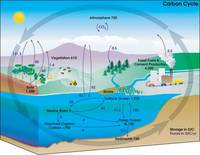What is Soil Carbon Sequestration?
Atmospheric concentrations of carbon dioxide can be lowered either by reducing emissions or by taking carbon dioxide out of the atmosphere and storing in terrestrial, oceanic, or freshwater aquatic ecosystems. A sink is defined as a process or an activity that removes greenhouse gas from the atmosphere. The long-term conversion of grassland and forestland to cropland (and grazing lands) has resulted in historic losses of soil carbon worldwide but there is a major potential for increasing soil carbon through restoration of degraded soils and widespread adoption of soil conservation practices.
FAO is concerned with the effect of agriculture on climate change, the impact of climate change on agriculture and with the role that agriculture can play in mitigating climate change. Historically, land-use conversion and soil cultivation have been an important source of greenhouse gases (GHGs) to the atmosphere. It is estimated that they are still responsible for about one-third of GHG emissions.
However, improved agricultural practices can help mitigate climate change by reducing emissions from agriculture and other sources and by storing carbon in plant biomass and soils. The work of FAO aims to identify, develop and promote cultural practices that reduce agricultural emissions and sequester carbon while helping to improve the livelihoods of farmers, especially in developing countries, through increased production and additional incomes from carbon credits under the mechanisms that have emerged since the Kyoto Protocol.
The objective is to reverse land degradation due to deforestation and inadequate land use/management in the tropics and sub-tropics through the promotion of improved land use systems and land management practices which provide win-win effects in terms of economic gains and environmental benefits, a greater agro-biodiversity, and improved conservation and environmental management and increased carbon sequestration.
The development of agriculture during the past centuries and particularly in last decades has entailed depletion of substantive soil carbon stocks. Agricultural soils are among the planet's largest reservoirs of carbon and hold potential for expanded carbon sequestration (CS), and thus provide a prospective way of mitigating the increasing atmospheric concentration of CO2. It is estimated that soils can sequester around 20 Pg C in 25 years, more than 10 % of the anthropogenic emissions.
At the same time, this process provides other important benefits for soil, crop and environment quality, prevention of erosion and desertification and for the enhancement of bio-diversity. Land degradation, does not only reduce crop yields but often reduces the carbon content of agro-ecosystems, and may reduce biodiversity. It is therefore important to identify what important synergies can be found in the area of soil carbon sequestration between the three UN conventions: UNFCC, UNCCD and UNCBD.
Carbon sequestration activities have been supported through the CDM (Clean Development Mechanism) under the Kyoto protocol with a focus on afforestation and reforestation, seen as being the most effective and readily measurable means to sequester carbon as biomass both above and below ground. In the post-Kyoto negotiations efforts are being made to give due attention to the huge carbon sequestration potentials in rangelands.

